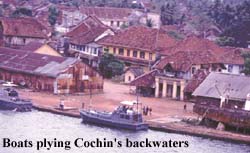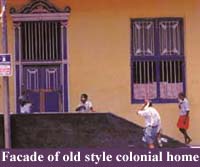 Cochin's
old world charm Cochin's
old world charm
WILLINGDON ISLAND, INDIA: "There is nothing much to see on the
island," the Dutch tour manager told passengers on board the Marco
Polo cruise liner. His casual dismissal of Willingdon island downplayed
its role in making Cochin the most important port on the Malabar coast,
known as the Queen of the Arabian Sea.
 Willingdon
island is man made. Perhaps that is what makes it charmless to those expecting
the excitement and colour of an Indian port. It was created in colonial
days with material dredged while deepening Cochin's harbour. Now it is
a new international air gateway to India with an international airport
just opened in support of its seaport. The Southern Naval Command Headquarters
of India is also there and several Sri Lankans are receiving training on
the island under the Indian Navy's auspices. Willingdon
island is man made. Perhaps that is what makes it charmless to those expecting
the excitement and colour of an Indian port. It was created in colonial
days with material dredged while deepening Cochin's harbour. Now it is
a new international air gateway to India with an international airport
just opened in support of its seaport. The Southern Naval Command Headquarters
of India is also there and several Sri Lankans are receiving training on
the island under the Indian Navy's auspices.
The island's broad, leafy avenues and quiet administrative buildings
suggest a somnolence that is deceiving. One of India's most enjoyable small
hotels, the Casino, is located on Willingdon island. It began life as a
cafe serving passengers at the Cochin Harbour Rail Terminus, just across
the road from its entrance. The owner added some rooms and called it the
Casino Hotel to attract attention. There is still no Casino but it has
grown into a favourite place to stay for both Indian and foreign tourists.
The luxury Taj Malabar hotel is also on the island.
Regular ferries and canoes- for-hire ply the waterways, linking Willingdon
Island with the Cochin mainland and there is also a road bridge. In the
wake of following fashion by the authorities in "Indianising"
the names of important cities, Cochin has fallen subject to the decree
that it is to be called Kochi. This pedantry has not changed the charm
of the old town's narrow streets where they lead through a maze of solid
buildings capped with red tiled roofs.
Sightseeing along these mysterious alleyways is not a risky activity
although hurrying men humping sacks to warehouse doors means the idle stroller
might be hustled in the rush. At one side of a square dedicated to hubbub
is the Pepper Exchange Building, evidence of Cochin's status in the world's
pepper and spice trade. At the other side are antique shops.
There are several similar emporiums stuffed with curios down the lanes
leading from the square. They are like the alleyways around Mombasa's Fort
Jesus, or those of Zanzibar's Stone Town. Because of its synagogue, built
in 1568, the area is known as Jew Town. Shops offer antique collectors
a wonderful selection of old prints and knickknacks from British Empire
days as well as classy reproductions of old watches, bronzes, boxes and
bangles that are cheerfully passed off to the gullible as the real thing.
Since these mass-produced fakes are small, they make ideal souvenirs to
carry home and boast about.
The signature photograph of Willingdon Island and Cochin is the line
of Chinese fishing nets that decorates the waterfront and the banks of
the backwaters. The nets, named after traders from China who are credited
with introducing them, dip into the water by manipulation of their wooden
frames to scoop up shoals of fish swimming near the shore.
Stalls selling the fish line the beach opposite St Francis' Church,
constructed in 1510 and believed to be India's oldest European-built church.
A separate stall serves as a kitchen and fish bought on the beach is cooked
there with generous portions of garlic and spices. Diners sit on streetside
benches, trying to ignore the flies, crows, scavenging cats, street urchins
and postcard vendors as they taste fish fit for gourmets.
The backwaters that extend east and south from the harbour are dotted
with tiny islands formed by alluvial deposits from the rivers. These rivers
have become popular for cruising, making the backwaters one of Kerala's
prime attractions for visitors.
 Cochin's
own appeal is in its links with history. As one of the finest natural harbours
in the world, it was the focus for trading in both goods and knowledge.
From time immemorial, Arabs and Chinese, and then Portuguese, Dutch and
British seafarers followed the sea route to Cochin and left their impressions
on the harbour town. Cochin's
own appeal is in its links with history. As one of the finest natural harbours
in the world, it was the focus for trading in both goods and knowledge.
From time immemorial, Arabs and Chinese, and then Portuguese, Dutch and
British seafarers followed the sea route to Cochin and left their impressions
on the harbour town.
As well as religious monuments, there is the Dutch Palace, actually
built by the Portuguese and presented to the Rajah of Cochin in 1555. The
Dutch never occupied it, the name came following repairs to it by the Dutch
in 1663. As Mattancherry Palace, it became the coronation hall of the Rajahs
of Cochin, and is now a portrait gallery.
Travel Notes: AirLanka flies to Trivandrum from where there are many
trains or coaches northwards through Kerala to Cochin, or by backwater
boats to Willingdon Island.
|







